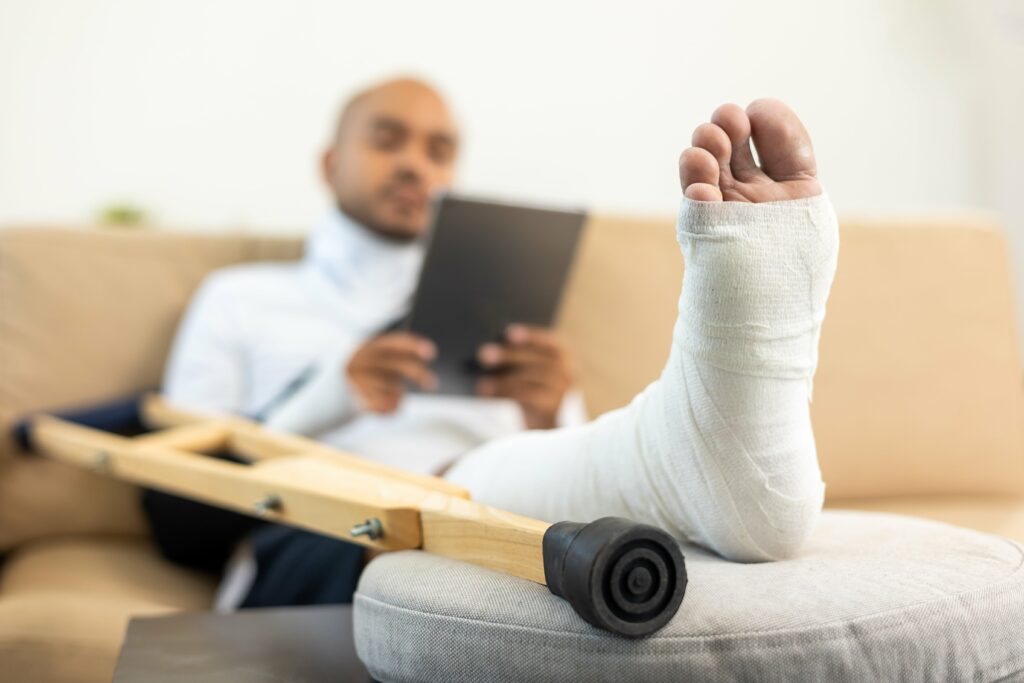Your feet and ankles are marvels of engineering, supporting your body weight, absorbing shock, and propelling you forward. However, like any complex structure, they are susceptible to a range of issues that can affect your mobility and quality of life. In this article, we delve into the five most prevalent foot and ankle problems, offering insights into their causes, symptoms, treatment options, and preventive measures.
1. Plantar Fasciitis:
Plantar fasciitis tops the list as one of the most common foot ailments. This condition involves inflammation of the plantar fascia, a thick band of tissue that connects your heel bone to your toes. It often presents as stabbing pain near the heel, particularly upon taking the first steps in the morning or after long periods of rest. Plantar fasciitis can result from overuse, improper footwear, tight calf muscles, or biomechanical issues.
Treatment:
- Rest: Limit activities that exacerbate pain and give your feet ample time to heal.
- Stretching exercises: Gentle stretches for the calf muscles and plantar fascia can help alleviate tension.
- Orthotics: Custom orthotic inserts or supportive footwear can provide additional cushioning and arch support.
- Physical therapy: Targeted exercises and manual therapies can improve flexibility and strength.
- Night splints: Wearing a splint overnight can maintain a gentle stretch in the plantar fascia.
Prevention:
- Choose supportive footwear with adequate arch support and cushioning.
- Gradually increase the intensity and duration of physical activities to avoid overloading the feet.
- Incorporate stretching exercises into your daily routine, paying particular attention to the calves and plantar fascia.
2. Achilles Tendinitis:
The Achilles tendon, the largest tendon in the body, connects the calf muscles to the heel bone. Achilles tendinitis occurs when this tendon becomes inflamed, leading to pain and stiffness, especially during physical activity. Common causes include overuse, sudden increases in exercise intensity, tight calf muscles, and improper footwear.
Treatment:
- Rest: Avoid activities that aggravate symptoms and allow the tendon to heal.
- Ice therapy: Applying ice to the affected area can reduce pain and inflammation.
- Eccentric exercises: Controlled, eccentric strengthening exercises can help rehabilitate the Achilles tendon.
- Physical therapy: Modalities such as ultrasound and massage therapy can promote healing and improve flexibility.
- Orthotics: Heel lifts or inserts may be recommended to reduce stress on the Achilles tendon.
Prevention:
- Gradually increase the intensity and duration of exercise to prevent overloading the Achilles tendon.
- Stretch the calf muscles regularly to maintain flexibility.
- Choose appropriate footwear with adequate heel support and cushioning.
3. Ankle Sprains:
Ankle sprains are among the most common musculoskeletal injuries, often occurring when the ligaments that support the ankle stretch or tear due to sudden twisting or rolling movements. Symptoms include pain, swelling, bruising, and difficulty bearing weight on the affected ankle. Factors contributing to ankle sprains include sports activities, uneven terrain, improper footwear, and weak ankle muscles.
Treatment:
- R.I.C.E. therapy: Rest, ice, compression, and elevation can help alleviate pain and swelling.
- Immobilization: In severe cases, a brace, splint, or walking boot may be necessary to stabilize the ankle.
- Physical therapy: Strengthening and balance exercises can restore stability and prevent future injuries.
- NSAIDs: Nonsteroidal anti-inflammatory drugs may be used to reduce pain and inflammation.
Prevention:
- Wear supportive footwear appropriate for the activity.
- Incorporate exercises that strengthen the muscles surrounding the ankle joint.
- Use caution when participating in sports or activities with a high risk of ankle injury.
4. Bunions:
A bunion is a bony bump that forms at the base of the big toe, causing it to deviate towards the other toes. This misalignment can lead to pain, swelling, and difficulty wearing shoes. Bunions often develop due to genetics, wearing tight or ill-fitting footwear, or biomechanical issues such as flat feet or excessive pronation.
Treatment:
- Footwear modifications: Wearing shoes with a wide toe box can alleviate pressure on the bunion.
- Orthotics: Custom orthotic inserts may help redistribute pressure and correct biomechanical abnormalities.
- Padding and taping: Applying padding or tape to the bunion can provide symptomatic relief.
- NSAIDs: Over-the-counter pain relievers can help manage discomfort.
- Surgery: In severe cases, surgical intervention may be necessary to realign the toe joint and remove the bony prominence.
Prevention:
- Choose shoes with a wide toe box and adequate arch support to prevent pressure on the toes.
- Avoid high heels and narrow, pointed shoes that can exacerbate bunion formation.
- Address biomechanical issues with orthotic inserts or physical therapy.
5. Morton’s Neuroma:
Morton’s neuroma is a painful condition that affects the nerves between the toes, typically the third and fourth toes. It occurs when the nerve becomes compressed and inflamed, leading to symptoms such as sharp, shooting pain, tingling, or numbness in the toes. Contributing factors include wearing tight or narrow shoes, high heels, or participating in activities that involve repetitive pressure on the forefoot.
Treatment:
- Footwear modifications: Switching to shoes with a wider toe box can alleviate compression on the nerve.
- Orthotics: Custom orthotic inserts may provide support and cushioning to relieve symptoms.
- Corticosteroid injections: Injecting corticosteroids into the affected area can reduce inflammation and pain.
- Physical therapy: Stretching and strengthening exercises can improve foot mechanics and reduce nerve compression.
- Surgery: In severe cases, surgical excision of the neuroma may be considered to relieve symptoms.
Prevention:
- Wear shoes with a wide toe box and low heels to reduce pressure on the forefoot.
- Avoid activities that exacerbate symptoms, such as wearing tight or constrictive footwear.
- Maintain a healthy weight to reduce pressure on the feet and minimize the risk of neuroma formation.
Foot and ankle problems can significantly impact your mobility and overall well-being. By understanding the causes, symptoms, and treatment options for common conditions such as plantar fasciitis, Achilles tendinitis, ankle sprains, bunions, and Morton’s neuroma, you can take proactive steps to manage these issues effectively. Whether through conservative measures such as rest, stretching, and orthotics or more invasive interventions like surgery, addressing foot and ankle problems promptly can help alleviate pain, improve function, and enhance your quality of life. Remember, prevention is key, so prioritize proper footwear, biomechanical alignment, and healthy lifestyle habits to keep your feet and ankles happy and pain-free.
Getting Help for Foot & Pain:
So who should you turn to for relief from foot and ankle pain? Your best bet is to seek help from a qualified orthopedic specialist. Orthopedic doctors specialize in diagnosing and treating musculoskeletal issues, including those affecting the feet and ankles. By scheduling an appointment with an orthopedic specialist, you can undergo a thorough examination and diagnostic tests, such as X-rays, MRIs, or ultrasounds, to pinpoint the cause of your pain. From there, a personalized treatment plan can be crafted to address your specific needs.
At our orthopedic centers across Wake County, we are committed to providing top-notch care for foot and ankle conditions. Our team of fellowship-trained physicians offers a range of treatments, both surgical and non-surgical, aimed at restoring your mobility and relieving your pain. Whether you require immediate attention at our Urgent Care facilities or ongoing rehabilitation with our physical therapists, we’re here to help you get back on your feet and back to your daily activities. Don’t let foot and ankle pain hold you back any longer – schedule your appointment with us today by calling (919) 781-5600 or booking online.
– – – – – – –
The material contained on this site is for informational purposes only and DOES NOT CONSTITUTE THE PROVIDING OF MEDICAL ADVICE, and is not intended to be a substitute for independent professional medical judgment, advice, diagnosis, or treatment. Always seek the advice of your physician or other qualified healthcare providers with any questions or concerns you may have regarding your health.

